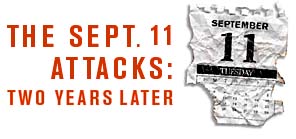
ASSOCIATED PRESS
With the Washington National Monument in the background, participants held candles in vigil during yesterday's National Day of Unity ceremony on the Mall in Washington, D.C.
Isles prepare
for the worstFederal funds help state agencies
train for the worst in bioterrorismNYC cop, war vet urge vigilance
No state or fed attack plan in 2001
Don't forget, victim's sister says
The massive infusion of federal funds to the state Health Department in the wake of 9/11 has given the agency's emergency response teams more personnel, more equipment, more training -- and huge new responsibilities.
Hawaii is receiving $10.3 million a year from the federal Health and Human Services Department to respond to terrorism and other public health emergencies.
"I'm seeing new equipment that I never thought I would ever see because I never thought we could afford it," said Jay Nakasone, chief of the state Radiological Emergency Response Team.
In two years the team has gone from a capability of handing midlevel crises to the ability to respond to a major radiological alert.
The team is not designed for first response, but is called in after high radiation levels are discovered. All the first responders -- the fire department hazardous materials teams in Hawaii -- carry Geiger counters.
"Hazmat teams go in assuming an 'all hazards' situation, and they test for everything," Nakasone said.
If they detect radiation, they call his team, which can fly anywhere in the state on military helicopters.
Nakasone noted that one of the major changes after 9/11 has been interagency cooperation and training. Previously, civilians were not allowed to ride on military helicopters.
"Now," he said, "all I have to do is show my ID card.
ASSOCIATED PRESS
Visitors to the World Trade Center site made their way around an outer fence yesterday in New York.
"We've got the training, we've got the Geiger counters, we've got more field-deployable equipment, we've got personal protection gear that can be used in any kind of environment," Nakasone said.
He estimated about half his team's time is spent training.
Bart Aronoff, manager of the Health Department's Bio-Terrorism Preparedness Team, said he has seen his program's annual budget balloon to $7.6 million a year compared with $600,000 annually before 9/11.
"Two years ago we had a very small program," he said. "In the past two years, we've doubled the number of investigators we have and we are available 24 hours a day."
The state has acquired highly sophisticated surveillance equipment to test for biological agents. The team's communications system has been expanded to include satellite downlinks.
The team also has large stores of medical supplies in warehouses to treat sudden outbreaks of any kind. And the federal government has Boeing 747 freighters packed with even more supplies that can be in Hawaii in six hours, Aronoff said.
The team's laboratory has become highly specialized and has gone to a staff of seven today from only one worker two years ago.
Unlike the other teams, which are completely headquartered on Oahu, the Bio-Terrorism Preparedness Team has members in place on the neighbor islands as well. It will be adding four new members to the Kauai division in the coming year and three each to the Maui and Big Island divisions.
Closely allied to the Bio-Terrorism Preparedness Team is the Disease Control Branch, which has both a field investigation team -- including medical doctors -- and a surveillance team made up of statisticians.
The branch is responsible for outbreaks of all communicable diseases except sexually transmitted diseases and HIV.
New personal protection gear now allows investigators to go into possibly hazardous environments in much greater safety.
Enhanced computer equipment has given it the capability to detect and react to disease outbreaks quickly.
"Close to 90 percent of the data we receive comes from the three laboratories in the state that provide testing for doctors. The data from all tests is sent to us electronically as soon as the test results are complete," said Michelle Nakata, Disease Control Branch chief.
All the teams have been participating in joint training exercises with state and local response teams throughout Hawaii.
Nakata said the SARS outbreak earlier this year -- there were several suspected cases in Hawaii, but none were confirmed -- gave her team its best opportunity to try out its new capabilities.
"SARS turned out to be a very good, very realistic experience for us," she said.


